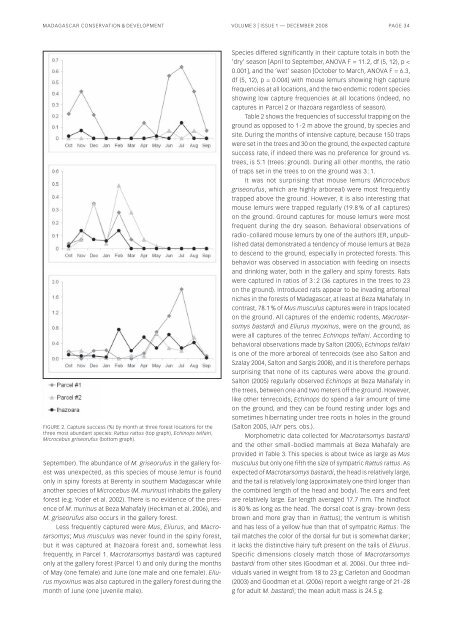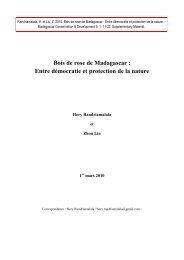Journal Madagascar Conservation - Madagascar Wildlife ...
Journal Madagascar Conservation - Madagascar Wildlife ...
Journal Madagascar Conservation - Madagascar Wildlife ...
Create successful ePaper yourself
Turn your PDF publications into a flip-book with our unique Google optimized e-Paper software.
MADAGASCAR CONSERVATION & DEVELOPMENT VOLUME 3 | ISSUE 1 — DECEMBER 2008 PAGE 34<br />
FIGURE 2. Capture success (%) by month at three forest locations for the<br />
three most abundant species: Rattus rattus (top graph), Echinops telfairi,<br />
Microcebus griseorufus (bottom graph).<br />
September). The abundance of M. griseorufus in the gallery for-<br />
est was unexpected, as this species of mouse lemur is found<br />
only in spiny forests at Berenty in southern <strong>Madagascar</strong> while<br />
another species of Microcebus (M. murinus) inhabits the gallery<br />
forest (e.g. Yoder et al. 2002). There is no evidence of the presence<br />
of M. murinus at Beza Mahafaly (Heckman et al. 2006), and<br />
M. griseorufus also occurs in the gallery forest.<br />
Less frequently captured were Mus, Eliurus, and Macrotarsomys;<br />
Mus musculus was never found in the spiny forest,<br />
but it was captured at Ihazoara forest and, somewhat less<br />
frequently, in Parcel 1. Macrotarsomys bastardi was captured<br />
only at the gallery forest (Parcel 1) and only during the months<br />
of May (one female) and June (one male and one female). Eliurus<br />
myoxinus was also captured in the gallery forest during the<br />
month of June (one juvenile male).<br />
Species differed significantly in their capture totals in both the<br />
‘dry’ season [April to September, ANOVA F = 11.2, df (5, 12), p <<br />
0.001], and the ‘wet’ season [October to March, ANOVA F = 6.3,<br />
df (5, 12), p = 0.004] with mouse lemurs showing high capture<br />
frequencies at all locations, and the two endemic rodent species<br />
showing low capture frequencies at all locations (indeed, no<br />
captures in Parcel 2 or Ihazoara regardless of season).<br />
Table 2 shows the frequencies of successful trapping on the<br />
ground as opposed to 1 - 2 m above the ground, by species and<br />
site. During the months of intensive capture, because 150 traps<br />
were set in the trees and 30 on the ground, the expected capture<br />
success rate, if indeed there was no preference for ground vs.<br />
trees, is 5:1 (trees : ground). During all other months, the ratio<br />
of traps set in the trees to on the ground was 3 : 1.<br />
It was not surprising that mouse lemurs (Microcebus<br />
griseorufus, which are highly arboreal) were most frequently<br />
trapped above the ground. However, it is also interesting that<br />
mouse lemurs were trapped regularly (19.8 % of all captures)<br />
on the ground. Ground captures for mouse lemurs were most<br />
frequent during the dry season. Behavioral observations of<br />
radio - collared mouse lemurs by one of the authors (ER, unpublished<br />
data) demonstrated a tendency of mouse lemurs at Beza<br />
to descend to the ground, especially in protected forests. This<br />
behavior was observed in association with feeding on insects<br />
and drinking water, both in the gallery and spiny forests. Rats<br />
were captured in ratios of 3 : 2 (36 captures in the trees to 23<br />
on the ground). Introduced rats appear to be invading arboreal<br />
niches in the forests of <strong>Madagascar</strong>, at least at Beza Mahafaly. In<br />
contrast, 78.1 % of Mus musculus captures were in traps located<br />
on the ground. All captures of the endemic rodents, Macrotarsomys<br />
bastardi and Eliurus myoxinus, were on the ground, as<br />
were all captures of the tenrec Echinops telfairi. According to<br />
behavioral observations made by Salton (2005), Echinops telfairi<br />
is one of the more arboreal of tenrecoids (see also Salton and<br />
Szalay 2004, Salton and Sargis 2008), and it is therefore perhaps<br />
surprising that none of its captures were above the ground.<br />
Salton (2005) regularly observed Echinops at Beza Mahafaly in<br />
the trees, between one and two meters off the ground. However,<br />
like other tenrecoids, Echinops do spend a fair amount of time<br />
on the ground, and they can be found resting under logs and<br />
sometimes hibernating under tree roots in holes in the ground<br />
(Salton 2005, IAJY pers. obs.).<br />
Morphometric data collected for Macrotarsomys bastardi<br />
and the other small - bodied mammals at Beza Mahafaly are<br />
provided in Table 3. This species is about twice as large as Mus<br />
musculus but only one fifth the size of sympatric Rattus rattus. As<br />
expected of Macrotarsomys bastardi, the head is relatively large,<br />
and the tail is relatively long (approximately one third longer than<br />
the combined length of the head and body). The ears and feet<br />
are relatively large. Ear length averaged 17.7 mm. The hindfoot<br />
is 80 % as long as the head. The dorsal coat is gray - brown (less<br />
brown and more gray than in Rattus); the ventrum is whitish<br />
and has less of a yellow hue than that of sympatric Rattus. The<br />
tail matches the color of the dorsal fur but is somewhat darker;<br />
it lacks the distinctive hairy tuft present on the tails of Eliurus.<br />
Specific dimensions closely match those of Macrotarsomys<br />
bastardi from other sites (Goodman et al. 2006). Our three individuals<br />
varied in weight from 18 to 23 g; Carleton and Goodman<br />
(2003) and Goodman et al. (2006) report a weight range of 21 - 28<br />
g for adult M. bastardi; the mean adult mass is 24.5 g.



